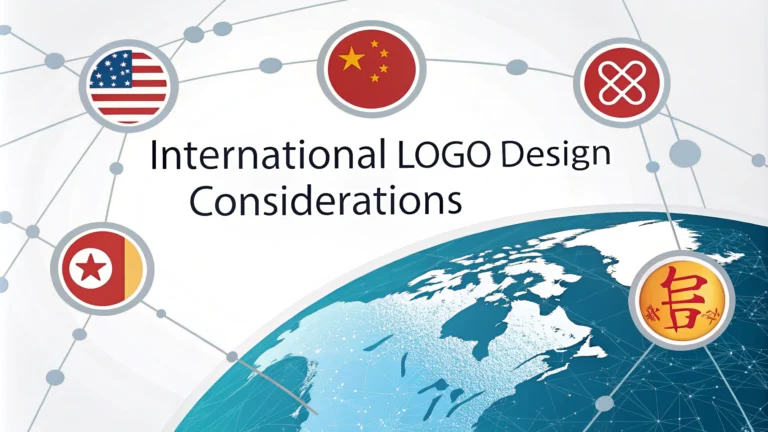Creating logos that resonate across different cultures requires deep understanding of international design principles and cultural sensitivities.
Color Considerations
- Red: Symbolizes luck in China, danger in Western cultures
- White: Represents death in many Asian cultures, purity in Western nations
- Green: Sacred in Islamic cultures, associated with nature globally
- Purple: Links to royalty in Europe, spirituality in Thailand
Research local color meanings thoroughly before finalizing any design choices for international markets.
Symbol and Shape Guidelines
- Avoid religious symbols unless specifically relevant to the brand
- Research cultural taboos regarding certain animals or objects
- Consider reading direction (right-to-left vs left-to-right) in logo layout
- Use universal shapes when targeting multiple regions
Typography Tips
- Select fonts that work across multiple alphabets
- Ensure readability in both small and large sizes
- Consider how the typeface translates into different writing systems
- Test logos in all relevant language versions
Technical Considerations
- Design scalable versions for various applications
- Create variations for different background colors
- Ensure the logo works in both print and digital formats
- Prepare black and white versions for universal use
Legal Checks
Research trademark laws in each target market before finalizing the design.
Testing Recommendations
- Test with focus groups from target markets
- Consult with local marketing experts
- Check translations and transliterations
- Verify cultural appropriateness with native consultants
Common Pitfalls to Avoid
- Using gestures that may be offensive in certain cultures
- Incorporating nationally protected symbols
- Assuming Western design principles apply universally
- Overlooking local competition and similar logos
Contact the International Trademark Association (www.inta.org) for guidance on international trademark registration.
For professional design assistance, consider working with agencies specializing in cross-cultural branding like Interbrand (www.interbrand.com) or Landor (www.landor.com).
Implementation Strategy
- Create a detailed timeline for design and testing phases
- Establish clear feedback channels with regional representatives
- Document all cultural research and design decisions
- Plan for periodic logo reviews and updates
Digital Adaptation
Social Media Requirements
- Design square, circular, and rectangular variations
- Create responsive versions for different platforms
- Ensure clarity at small sizes for mobile devices
- Prepare animated versions where appropriate
Brand Guidelines
- Develop comprehensive usage guidelines for each region
- Include cultural context and restrictions
- Specify color codes and acceptable variations
- Document localization requirements
Future-Proofing
- Plan for potential market expansions
- Consider emerging technology requirements
- Create flexible design systems
- Document modification procedures
Conclusion
Successful cross-cultural logo design requires thorough research, careful planning, and extensive testing. Consider cultural sensitivities, technical requirements, and legal implications throughout the design process. Regular reviews and updates ensure continued relevance across all markets.
Remember that a well-designed cross-cultural logo serves as a universal ambassador for your brand, bridging cultural differences while maintaining brand integrity.
FAQs
- What are the key cultural considerations when designing logos for international markets?
Colors, symbols, and gestures can have different meanings across cultures. For example, white symbolizes death in some Asian cultures, while red is considered lucky in China but can signal danger in Western countries. - How do I ensure my logo design is legible across different writing systems?
Logo designs must maintain clarity when translated into different scripts like Arabic, Chinese, or Cyrillic. Consider leaving adequate space for text and using fonts that are compatible with multiple writing systems. - What legal checks should I perform when designing international logos?
Conduct thorough trademark searches in target markets, verify cultural ownership rights of symbols, and check if specific design elements are protected in different countries. - Should I adapt my logo’s colors for different international markets?
Yes, colors should be adapted based on cultural significance, local competitors, and regional preferences. For instance, orange signifies mourning in the Middle East but represents energy and creativity in Western markets. - How do religious sensitivities affect international logo design?
Religious symbols, even when unintentional, should be carefully avoided unless specifically relevant. Certain geometric patterns or imagery may have religious significance in different cultures. - What technical considerations are important for international logo designs?
Logos must be scalable, work in both digital and print formats, and maintain clarity across different size requirements for various international platforms and media. - How should I handle logo localization for different markets?
Create flexible logo designs that can accommodate different language versions, consider modular elements that can be adapted, and maintain consistent brand recognition across variations. - What file formats are essential for international logo distribution?
Provide vector formats (AI, EPS, SVG) for scalability, along with common raster formats (JPEG, PNG) in CMYK and RGB color spaces to meet various international printing and digital standards. - How do I ensure my logo works across different devices and platforms globally?
Design responsive logos that remain effective across various screen sizes, resolutions, and platforms while considering different technical standards in various countries. - What research should be conducted before designing an international logo?
Research local market preferences, competitor analysis, cultural symbolism, color meanings, and linguistic implications in target markets while consulting with local experts or focus groups.








